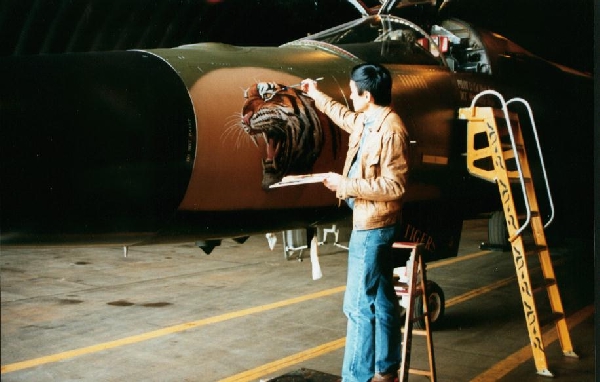|
|
Nose ArtFrom Wikipedia, the free encyclopedia Not to be confused with nose-jewels or nose piercing. While begun for practical reasons of identifying friendly units, the practice evolved to express the individuality often constrained by the uniformity of the military, to evoke memories of home and peacetime life, and as a kind of psychological protection against the stresses of war and the probability of death. The appeal, in part, came from nose art not being officially approved, even when the regulations against it were not enforced.[1][2] Because of its individual and unofficial nature, it is considered folk art, inseparable from work as well as representative of a group.[1] It can also be compared to sophisticated graffiti. In both cases, the artist is often anonymous, and the art itself is ephemeral. In addition, it relies on materials immediately available.[1] Nose art is largely a military tradition, but civilian airliners operated by the Virgin Group feature "Virgin Girls" on the nose as part of their livery. In a broad sense, the tail art of several airlines such as the Eskimo of Alaska Airlines, can be called "nose art", as are the tail markings of present-day U.S. Navy squadrons. There were exceptions, including 8th Air Force B-17 "Whizzer", which had its girl-riding-a-bomb on the dorsal fin.
Many aviation artists will be familiar with the decorative figures they have occasionally had to paint on the warplanes in their paintings. They would have appreciated the personality and colour these decorations immediately impart to the otherwise often dour combat aircraft. Examples like the fierce shark-mouthed P40 Warhawks of the AVG Flying Tiger group quickly spring to mind. But not that many artists have actually had to put brush to metal down in the hangars. My sole experience came in the 90’s, when the mighty F-111s of the USAF were being repatriated to the US, having been replaced in the UK by the newer F-15E Strike Eagles. The F-111*, often called the “Aardvark”, was a remarkable aircraft which remains to this day surprisingly little known and appreciated. It had a checkered developmental history, but it was the first operational aircraft to fully realise Barnes Wallis’ original concept of variable geometry and matured to become a highly effective strike bomber with prodigious power and range. Against its 73-foot length( same as a B-17 ) its emulator the Tornado looks distinctly pint-sized. At the height of the Cold War, throughout the 80’s and into the 90’s, the USAF operated 5 full squadrons from RAF Lakenheath and another 3 squadrons from RAF Upper Heyford, and inhabitants of the Scottish and Welsh outback must have been thoroughly familiar with the F-111’s raucous low-level manouevres . Yet when I came to have a painting of the plane in a Guild Annual at the time the perplexed exhibition catalogue mistranslated the type to be a “F11F-1”, a totally unrelated 60’s naval fighter jet. And one opening day viewer was overheard to remark on the odd appearance of “that Tornado?”. Well, not having had any previous experience for the job I naturally fell back on “materials immediately available”. The obvious choice was the quick-drying and tough acrylic paint I regularly used for underpainting on canvasses. The emblem required was fairly innocent compared to the often very sexualised figures which have often gone on to deployed RAF aircraft: a tiger’s head, the F-111E in question being the plane of the commander of the 79th “Tiger” Squadron at Upper Heyford. No problem, I had painted plenty of tigers in my wildlife work. I arrived at the airbase on the day and was duly shown to one of the numerous concrete and steel “pigloos” which sheltered the deadly bombers( and, rumours had it, numerous “nukes”). The HAS( Hardened Aircraft Shelter) concerned was shockingly cold and damp inside, with a constant drip-drip of moisture from the ceiling. I wasted no time and after first vigorously rubbing the selected area on the aircraft nose with an old towel to clean and dry it, I outlined the intended image with white chalk and then went straight on with the acrylic colours. I had to keep jumping back to look at the drawing....it's a bit tricky painting on a markedly curved surface. But I did it all in under 30 mins. I requested the ground crew to varnish over the tiger's head if possible after it was dry, in the faint hope that this would help keep the paint and plane together during the long transatlantic flight ahead. I was later informed, to my pleasant surprise, that the aircraft had arrived on the other side with nose art intact and pristine, to great appreciation and celebration. In fact they were so enamoured of it that they removed the nose panel with the tiger image and shipped it back to the UK....where it has since adorned the nose of that sleek F-111E in the prestigious American Air Museum at Duxford. Have a look next time you're down there. But don’t bother complaining to the staff that their splendid tiger-nosed F-111E should have the complementary black-and-yellow “tiger stripes” on its tail instead of the blue markings of an irrelevant unit. Cheers in this Year Of The Tiger Ronald Wong GAvA
*For more on the aircraft, and some of my commissioned work, see www.f-111.net
|
